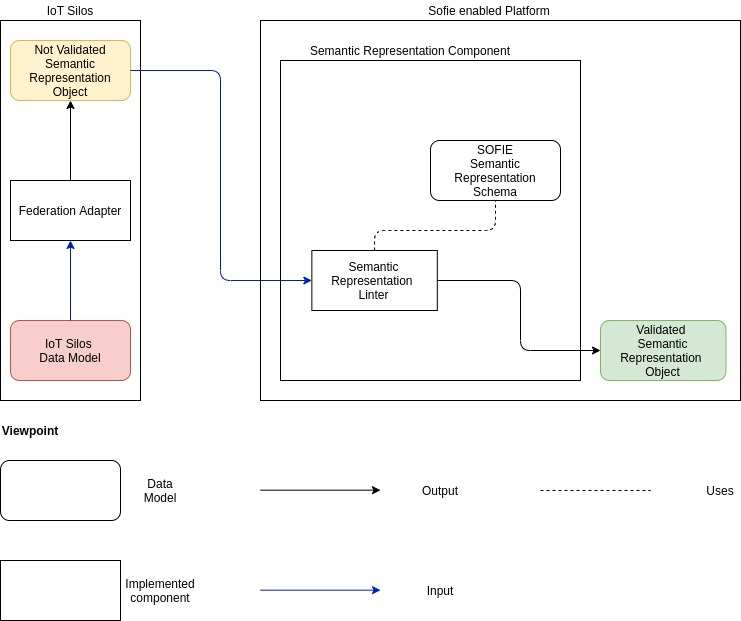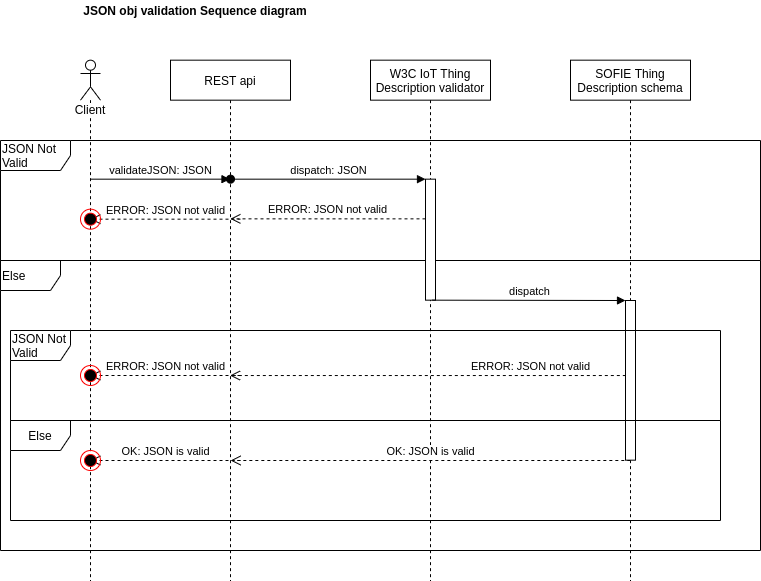Table of contents:
Exchanging data between different IoT platforms and systems can be challenging as the platforms often utilise different formats for their data representation and definition, and one system may not know which data model the other system can handle. The SOFIE Semantic Representation (SR) component mitigates this problem and restores semantic interoperability between systems and IoT platforms by allowing the definition and management of the semantics of the data. The semantic representation component typically offers two functionalities:
- Data semantic definition
- Data validation
As shown in the figure 1, systems implementing the SR enable interoperability by defining a data semantic which can be used by other entities to exchange data. The interoperability is achieved with a data model, which can be defined using different data representation standards, such as JSON schemas, W3C WoT Thing Description, but proprietary models can also be implemented when required by the application. This data model is then managed by the SR component, which allows users to define the accepted data models in the system. An example could be the definition of security rules in the schema stored in the SR component: defining the security rules enforces third parties’ schema implementations to satisfy them if they want to communicate with the system. Another example is the definition of a schema which defines the main properties and interfaces of the IoT devices that can interact with the system.
Figure 1 : Semantic Representation system interoperability
This chapter shows different views to explain the component architecture.
Figure 2: Object flow view
Table 1: Component description
| Name | Description |
|---|---|
| IoT Silos | This element represents an external stakeholder’s composition of IoT devices. They offer functionalities to external users and can be considered like a siloed platform which wants to join a SOFIE enabled platform |
| SOFIE enabled platform | This is can be considered like a project which is built with the SOFIE framework |
| IoT Silos Data Model | The data model of the IoT Silos. The SOFIE enabled platform cannot understand this data model |
| Federation adapter | The element is optional, but it translates the IoT silos Data Model into an object which can be used by a SOFIE enabled platform |
| Not Validated SR obj | This object can be the output of the Federation Adapter or it can be created in any way by the IoT silos owner. It describes the data of the IoT Silos in a structure understandable by the SOFIE enabled platform. |
| SR component | This component takes in input an object and return an object which is compliant with the SOFIE enabled platform semantic rules |
| SR Thing Description | This is the schema supported by the SOFIE enabled platform. Each platform implementation has a different schema, it should be sent to the SR Component as a parameter and can be updated during the SR Component lifetime. It is used to validate the object from IoT Silos |
| SR linter | This is a sub-component of the Semantic Representation. It validates the object in input with the schema found in the SR Thing Description. If everything is good, it returns a validated object |
| Validated SR obj | The result of the SR linter. Is an object which contains the data of the IoT silos in a structure understandable by the SOFIE enabled platform and its components |
The Figure 3 shows an example for Thing Description where it is defined the acceptable information for the name and the age. The image then shows two JSON message, the one on the left is valid because it is concordant with the Thing Description rules. The message on the right instead is not valid and therefore will be rejected.
Figure 3: JSON message examples
| Thing description |
|---|
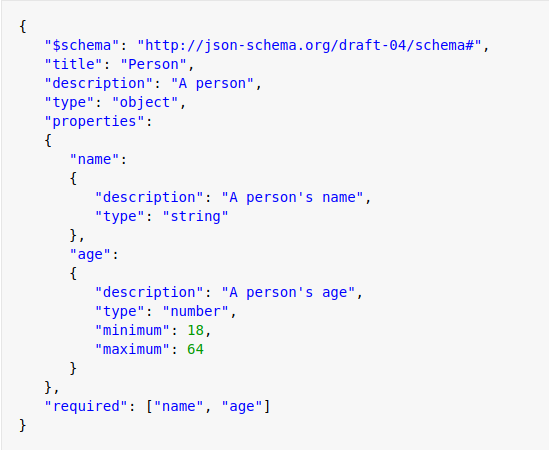 |
| Valid SR object | Not valid SR object |
|---|---|
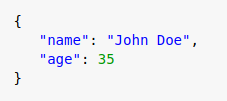 |
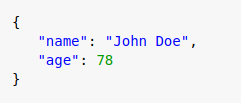 |
The following sequence diagram shows the main steps occuring when a system which uses SR validates a message
Figure 4: Semantic Representation validation process
| Decision | Technology | Description |
|---|---|---|
| Docker image os | Ubuntu 18.04 | Easy to handle with the chosen Data schema |
| API | Rest | A lightweight and widely used API architecture |
| Data schema | W3C WoT-TD | Dependent on SR component requirements |
| Data input | JSON | Easy to handle with the chosen Data schema |
The software modules are implemented in Python and the component uses the Flask framework to enable networking functionalities. Messages and data validation is performed using JSON schema validator.
The Semantic Representation component is standalone, it may be used by other SOFIE components and applications if necessary. SOFIE pilots use the Semantic Representation component for different purposes.
Context-aware Mobile Gaming utilises the component to assure that external beacons confirms to the correct licensing, before being added to the system.
The component can be used as a dockerized service or run as python app.
The prerequisites to use this component are the following:
- Docker
as python app:
- Make
- Python3
- Pip3
This chapter shows the steps to run the component as docker service in a linux machine. While in the component folder, use the following commands:
make setup
To run the component:
make run
by default the component runs on the internal port 5000 to external port 5000.
To modify the port change the variable PORT in the Makefile.
The component can handle JSON schemas, the user is free to create and use every JSON schema, the component has been tested using W3C WoT ThingDescription. Please, use those resources to learn how to create a schema.
Once the JSON schema has been defined, the user can add it to the component as in below example:
url = 0.0.0.0:5000/api/schema
schema = 'your_schema'
request.post(url, json=schema)
To validate any message against a schema, the latter must be configured as in the previous step. To validate the message you need the message and the id of the schema the user intend to validate the message against.
url = 0.0.0.0:5000/validate
example_msg = 'your_json_msg'
example_schema_id ='schema_id'
request.post(url, json='message': example_msg, 'schema_name': example_schema_id})
The full OpenApi are available on Swaggerhub
The component define a series of functional api tests. These tests check that from a defined input, the output are consistently correct.
To test the component, in cmd navigate in the component folder, then:
make test
To test the component, in cmd navigate in the component folder, then:
make clean
The user can evaluate the status of the component by running the tests. If all of them are positive then the component should run as intended.
The component, in the current state there is no major bug or missing functionality.
The component satisfy SOFIE project requirements and there is no plan to extend functionalities.
2020-09-17
Added
- Updated API design and performance upgrade
2020-08-07
Added
- Main validation functionalities
This component is licensed under the Apache License 2.0.

